By Kiša Lala
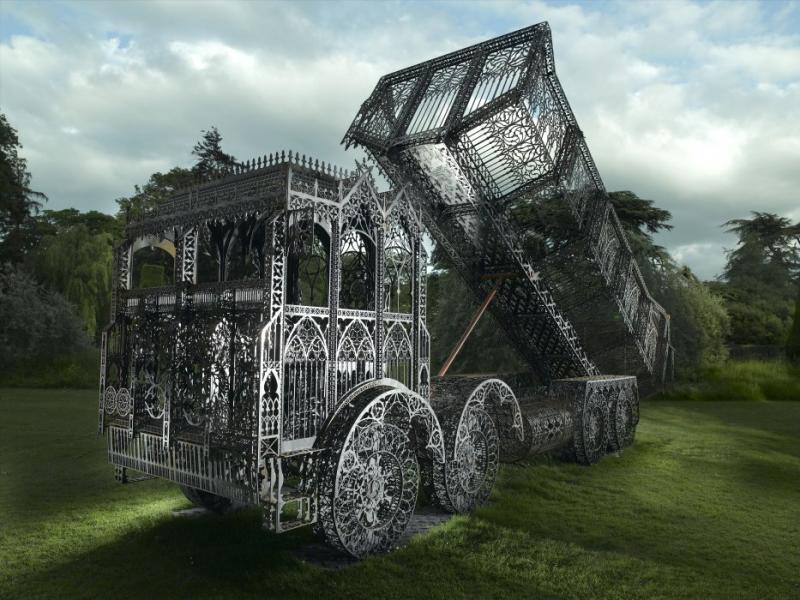
Dump Truck 2006 310 x 860 x 270 cm laser-cut corten steel © Wim Delvoye
Self described architect, prankster, farmer, megalomaniac: Wim Delvoye is an extreme artist, willing to chase an idea to its most unsettling resolution. To make his point Delvoye has mastered all the skills of the traditional artisan - from weaving, tattooing, ceramics, stained glass and steel - and he has also engineered the perfect specimens of shit.
Delvoye often triggers controversy but he is a stealth artist, astutely exposing all the finger-wagging snobbism about his art. He was in New York recently during Armory week, noting the changes in the Meat Packing District where he once lived in the late 90s. In 2001 he showed his Cloaca machine at the New Museum. "I thought it was going to be a disaster during the anthrax scare. It was a bio-machine making shit," said Delvoye with a hint of mischief. He knows the common notions people have about his art and will happily play up his schoolboy antics. Settling down to a chat, (he said, after a visit to the loo, a squeeze of his blackheads and a cup of coffee in hand), he takes me on a journey through his cosmicomical universe - being on the run from the Louis Vuitton police, his plans for a Gothic wonderland, and his friendship with Ai WeiWei. We are back at school again, listening to the schoolyard's prankster brag.
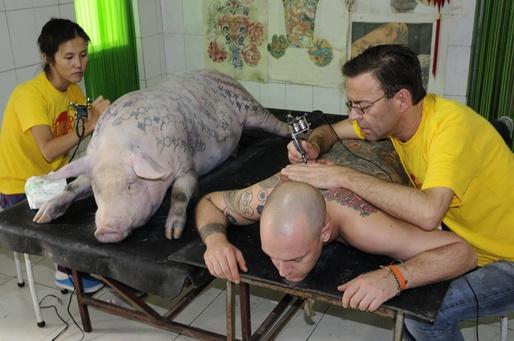
Art Farm - 2008. Delvoye Tattoos Pigs - © Wim Delvoye

Tour - Brussels: Media: Laser-cut corten steel Dimensions: H 1700 x 260 x 260 cm Date: 2010 View: Knockin' on heaven's door (20.10.2010 - 23.01.2011) at Bozar, Brussels, © Wim Delvoye
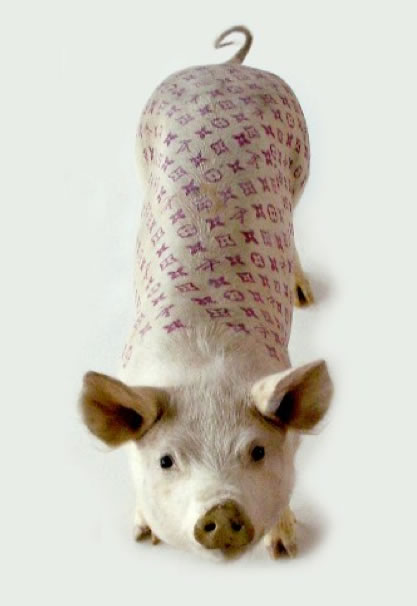
© Wim Delvoye
Tattooed Pigs and the Louis Vuitton Police
With an instinct to follow the next wave, Delvoye sold his NY place soon after 9/11 and moved to where it was more happening: he bought a pig farm in China. At his art farm Delvoye tattooed live pigs. Galleries were reluctant to show art that snorted and oinked, but says Delvoye, "I prefer showing them that way as a dead pig skin is a big compromise." The few art-pigs he has left will be kept until they die of old age before being parted from their precious hides, which purchasing collectors have to wait for. More contentious though, was the piece of pork with the Louis Vuitton logo branded on its back. The corporation being very particular about the usage of its brand, hounded Delvoye all the way to Shanghai in an attempt to confiscate the hides.
"The museum was quite primitive (in China) - and meanwhile I had these expensive suits visiting, trying to get at me, which was quite ridiculous," he recalled. "For a while they had big folders with my name on them, trying to sue me. It was scary. So, we were once archenemies!"
I said I was surprised they didn't appreciate the irony - and wasn't Arnault a collector of art himself?
"The owner of LV is much more of a perfectionist and a good manager, defending his products at all costs, than he is an art-lover - I mean loving art is just one of the many rings he has on his fingers," said Delvoye, adding candidly, "He is a mogul, and he has art to outsmart other moguls."
The brand's value was based on the notion of opulence and the company was sensitive to protecting this as it deemed fit. Still, an artist has the prerogative to comment on cultural iconography, and Delvoye had toyed with other brands over the last 15 years, including signing his name in Disney's signature characters, and playing off such ubiquitous cultural entities as Coca Cola and Procter & Gamble's Mr. Clean.
Delvoye believes that our imagination has been co-opted by powerful images: You cannot read the original Pinnochio without visualizing it in colours tainted by Disney. Recently, an American company had even filed for the rights of the word Om, in use for thousands of years in India. "There should be a counter-attack," he says, "for visual pollution. Big companies are paying taxes to the government: for the right to blow dirty air into the air. People on the way to work see these brands, bags and shoes; Brands attacking their collective memory."
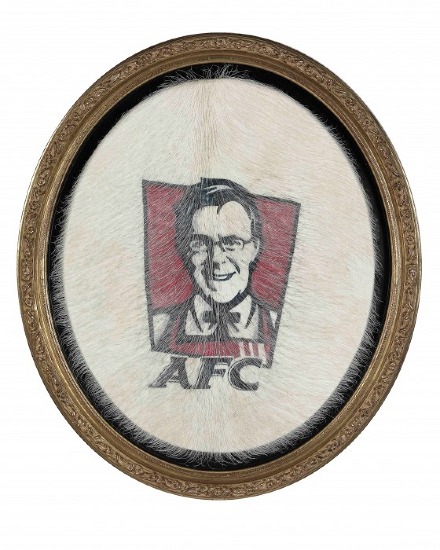
Tattooed Pigskins, Untitled (Art Farm China), 2005, tattooed pigskin on oval stretcher, handcarved gilded frame, H 58 x 50 cm, © Wim Delvoye
"If it came to a litigation I would have intellectually found it enjoyable," mused Delvoye. "It would be in everybody's interest whether I won or lost: it would make a case for all artists. The work I was doing never resulted in confusion between the two products. My second argument was that after a while, [a logo] becomes a part of collective [memory]. If you are so omnipresent in the city streets, then you have to take a joke," says Delvoye. He was amused by the fuss, but acknowledged that pigs were not very respected creatures in the world. It was a notable paradox then that LV had hired artist Scott Campbell to create tattooed designs on their leather-hide bags, and LV models pranced about with fashionably branded necks.
In the end, LV pursued the artist to Art Basel where under Swiss law the pigs might have been taken into custody, so Delvoye abandoned his plans and left the country. "It was such a nice pig, and I wanted to keep it..." he says wistfully.
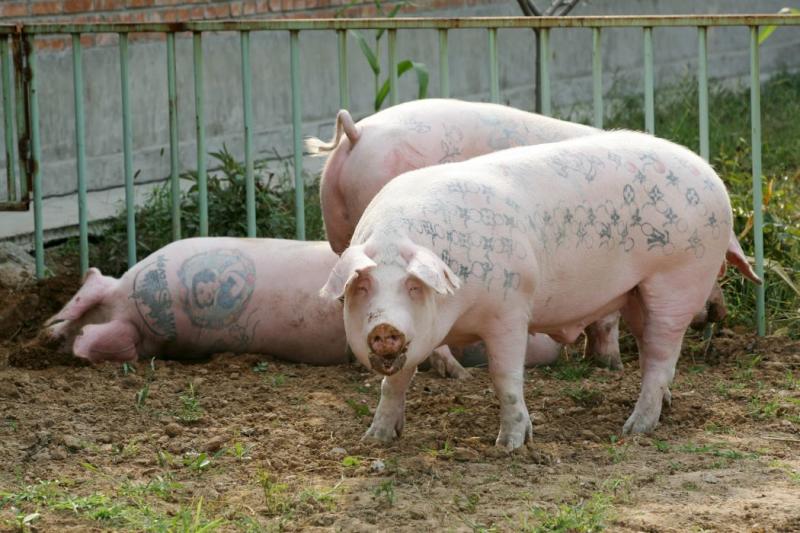
Live Tattooed Pigs, Art Farm © Wim Delvoye
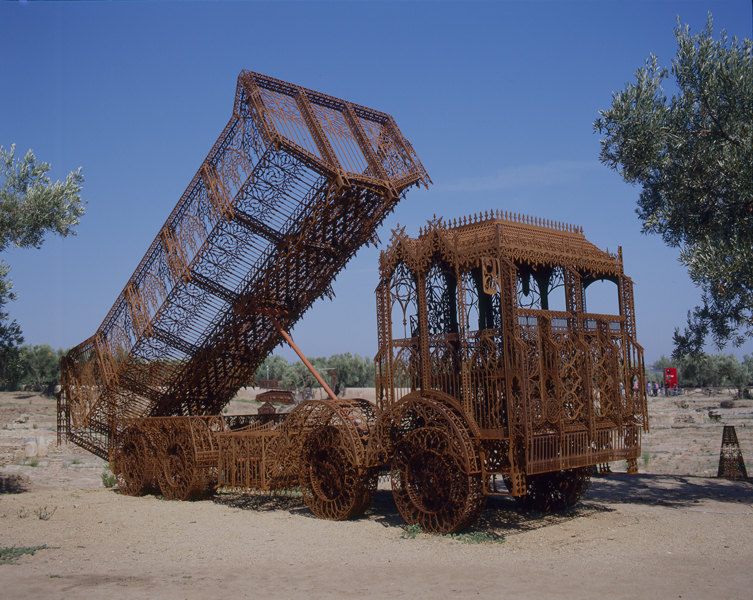
Dump truck - Catanzaro: Media: Laser-cut corten steel Dimensions: B 270 x H 295 x L 820 cm (scale 1:1) Date: 2006 Weight: 3720 kg © Wim Delvoye
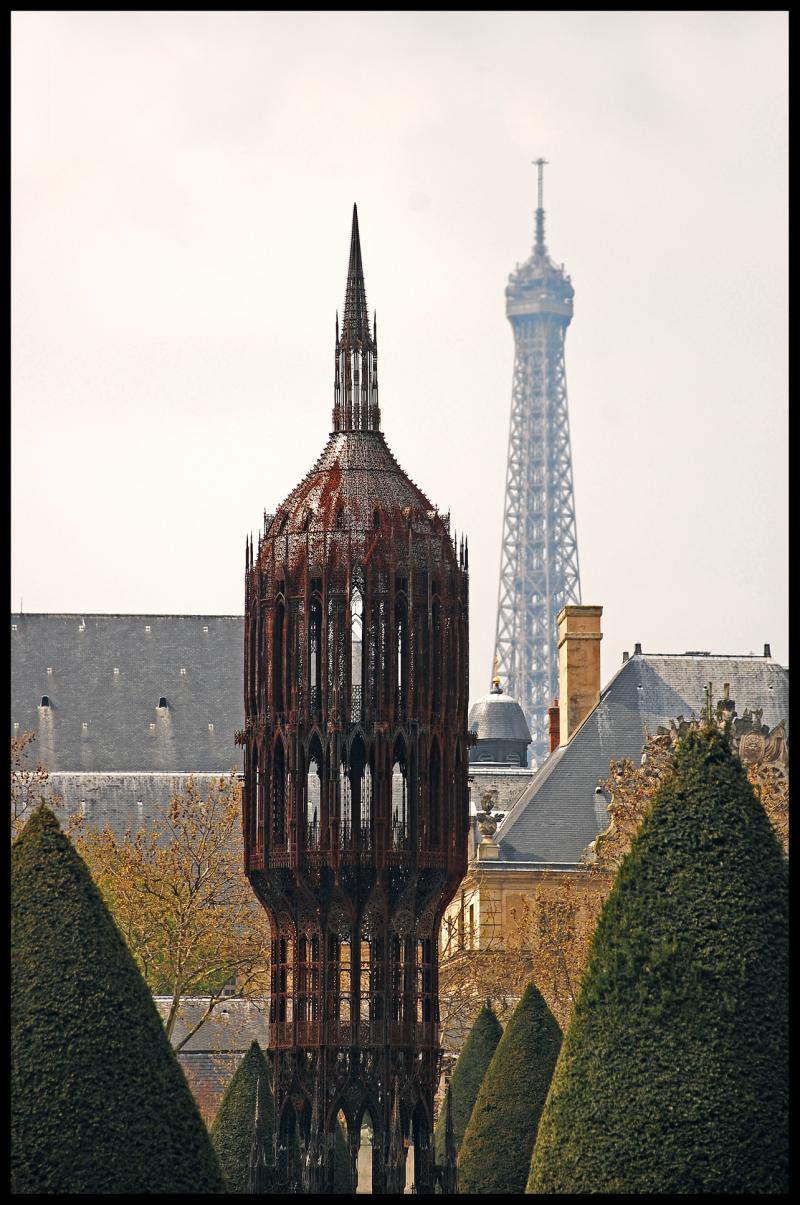
© Wim Delvoye Tour Paris 2010 700x700x 1200Laser-cut corten steel exhibition-at-Musee Rodin Paris France
Craftier the Better
Delvoye has always been playing on ideas of luxury and poverty. He grew up with the stuff his father would bring home from trips to the Congo: Via low-culture he came to understand high-culture. He knew more about kitschy, crafty things before he ever saw a 17th century table. In arts school he quickly learned that showing skillful work was a taboo and demoted you to the stature of a craftsman.
His early works with carpet weaving and tapestry shocked people because it overstepped convention and encroached the realm of the traditional arts, of folklore and artisanship. It was anti-modernist. It was high art vs. popular culture.
I posed that the most likely home of traditional crafts these days was with the tourism industry. "It is the forces of democratization," said Delvoye. "Everybody should have curtains in the house... machinery makes mass production possible; taste and quality get devalued."
The Shitting Machine: The Cloaca Project
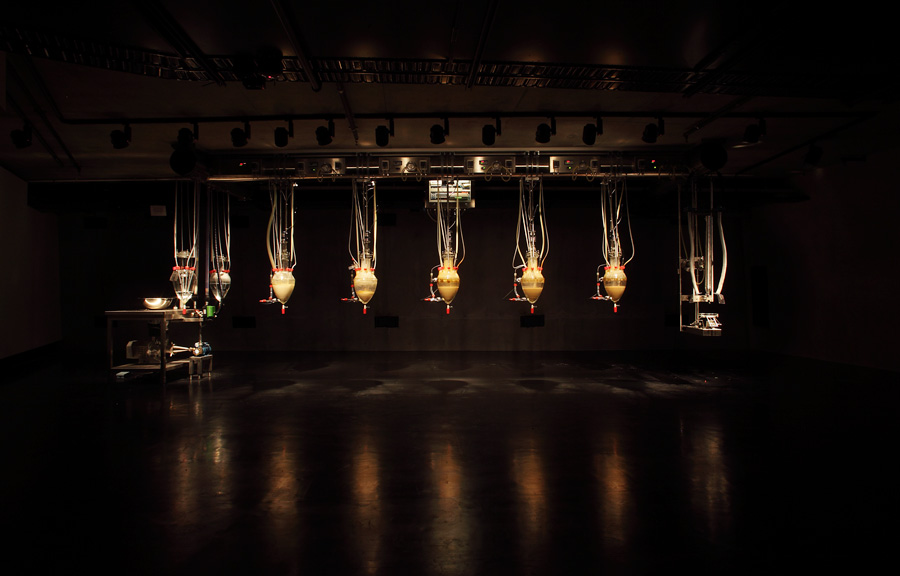
Cloaca Professional: Media: Mixed Media Dimensions: L 710 x B 176 x H 285 cm Date: 2010 View: Monasism (22. 01.2011 - 19.07.2011) at MONA ,Tasmania, © Wim Delvoye
David Walsh had purchased one of Delvoye's pooing machines for his MONA space in Tasmania. The subject brings out Delvoye's science-nerd-enthusiasm: "I always wanted to do a shit machine...you know I saw the film Willie Wonka and the Chocolate Factory as a little boy. It was like thinking about what it was like being a boy. Tracey Emin in every work from A to Z says she is a girl - there's not much else in her work. I think it's great, but what you read is, I'm a girl, I'm a bad girl, a funny girl... In the nineties [my] work was more about being a boy, now it is much more eclectic. The debates were coloured by identity, what subgroup you belonged to. It was about separation. The New Museum [exhibition of 2001], had been the temple for all these discussions; the debate about the Other."
In the 90s a lot of the art had been about declaring identities, whether one was black, gay, Mexican-American - and in many ways, Delvoye says, Cloaca was a response to that. He was a boy without shame. It was a more globalist statement: Shit. It was not about separation.
So did these separate identities have the same shit in common?
"It stopped all the quarrels. Between male, female, class/gender issues, ethnic groups, the self-definition of people. Staring at the shit machine they were all relieved - communally relieved. It was wonderful."
Delvoye received a different response to the work wherever he showed it. In France they removed the shit immediately. In Germany they scolded him for betraying the starving people of Africa; some asked why it did not produce anything of practical value like vitamins, or energy. Delvoye chuckled at all the didactic consternation, "I am not taking myself that seriously. It is a Calvinist taboo - wasting food," said Delvoye, and continued, "Somehow in Germany it's about never wasting a little potato. If you can't eat it, you put it back in the fridge. Everyday is about suffering for the people who are hungry in the world."
So does it actually smell like shit?
"Yes. And the consistency depends on the absorption of water. I am surprised Walsh [at MONA] is still feeding the machine...he may one day get tired of it. It goes through reactors and it is fully automatic like a fish tank. The bacteria in the colons take their time, I cannot tell the machine to do it faster, but it can make more shit than a human body; more timely...it's like saying I need to shit everyday at 1:30pm - because museums have to be open..."
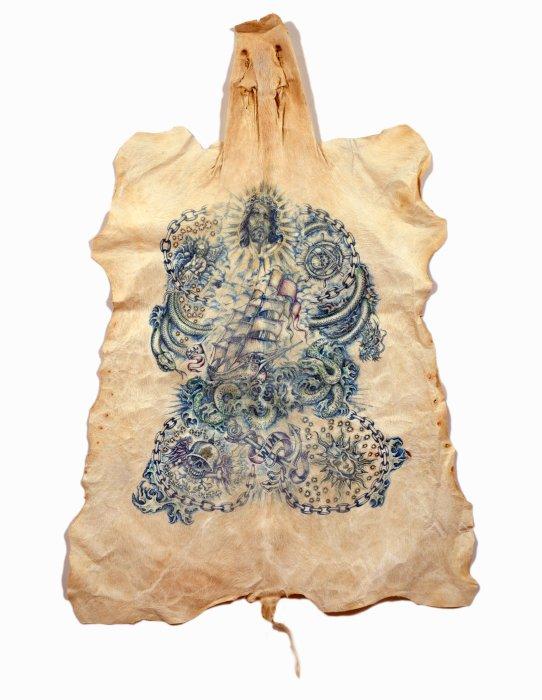
Untitled (Wim) 2006 167 x 137 cm tattoo on pigskin, tanned - © Wim Delvoye
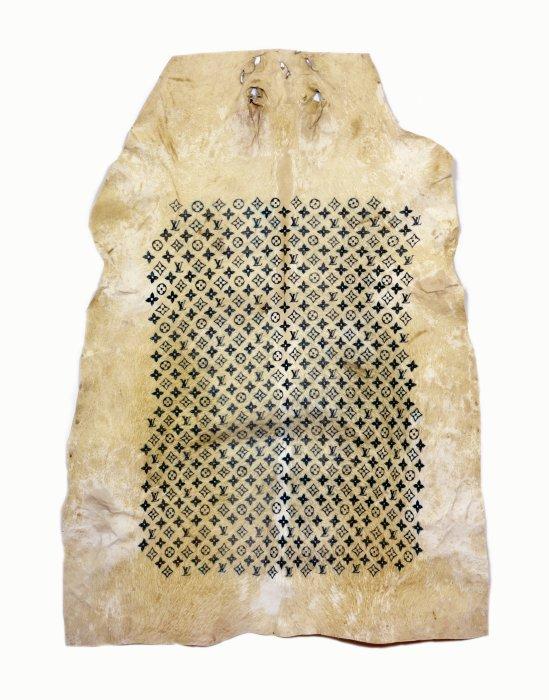
Art Farm Yang Zhen 2005 140x100cm tattoo on pigskin, tanned © Wim Delvoye
China, the Economy and Ai WeiWei
Delvoye had found Chinese galleries largely tolerant in exhibiting his works, and because we spoke before Ai Weiwei's detention, our conversation was lighthearted about his friendship with the artist. "He is a dear friend of mine. I regard him as one of my best friends out of all the artists on this planet. Yes we disagree gently about China. I have a much more positive regard for it than him. He thinks I am a naïve little boy and I should shut up about my praise for his country." Now, in light of recent events Delvoye's next shows in China should add some heat to the discussions at Urs Meile Beijing, the same gallery as Ai WeiWei's.
I say that that Ai Wei Wei's feelings must be similar to his own love-hate relationship with Belgium - and in fact Ai WeiWei though he had strongly split sentiments about his native country, was fond of Belgium. "Yes he probably likes my country as a revenge. His first show was in Belgium," says Delvoye with an impish snicker.
The two artists were filmed in a documentary, Into the Night, walking around Kassel together, in which Delvoye spends a good deal of time peeing off-camera, still microphoned, while the camera observes Ai Weiwei looking on mostly embarrassed - recounted Delvoye with glee. "When I see WeiWei I always kiss him, and on a certain day he said, oh I thought you were gay! The Chinese are not into kissing each other."
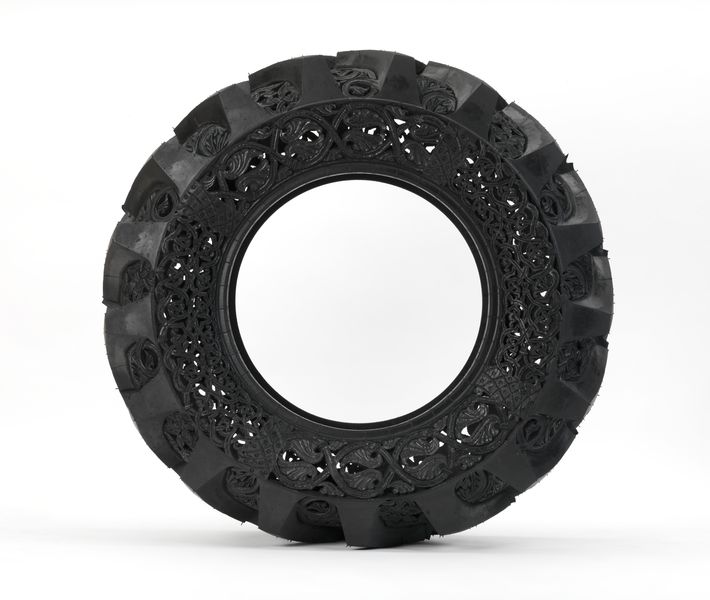
Car Tyres, Untitled 2009, handcarved car tyre, © Wim Delvoye

Cement Truck (scale model 1:6) 2010 158 x 36 x 68.5 cm Laser-cut corten steel - © Wim Delvoye
Delvoye is not impressed with sexuality. When he was in school, "there were lots of penises in the art world, lots of sexual organs - it was so fashionable," says Delvoye. "But sex was not so interesting in proportion to religion, shit, the market, the economy - these are actually much more taboo."
Looking inside the guts of the economy has, in fact, been a focus. Economics is more fundamental to our culture than the aspiration towards art as many ancient, ten thousand-year-old clay tablets tell us: They are usually invoices - love poems are a recent development. Charles Darwin borrowed the idea of Evolution as an analogy - a term mostly used in economics at his time, explained Delvoye.
To make light of art world economics, he created an art piece in which the buyer was given a money-back guarantee: The bond is valid for fifteen years during which the artist was obligated to pay anyone back who regretted their purchase. With mock gloom he tells me he can't leave Belgium anytime soon for fear someone might want to collect.
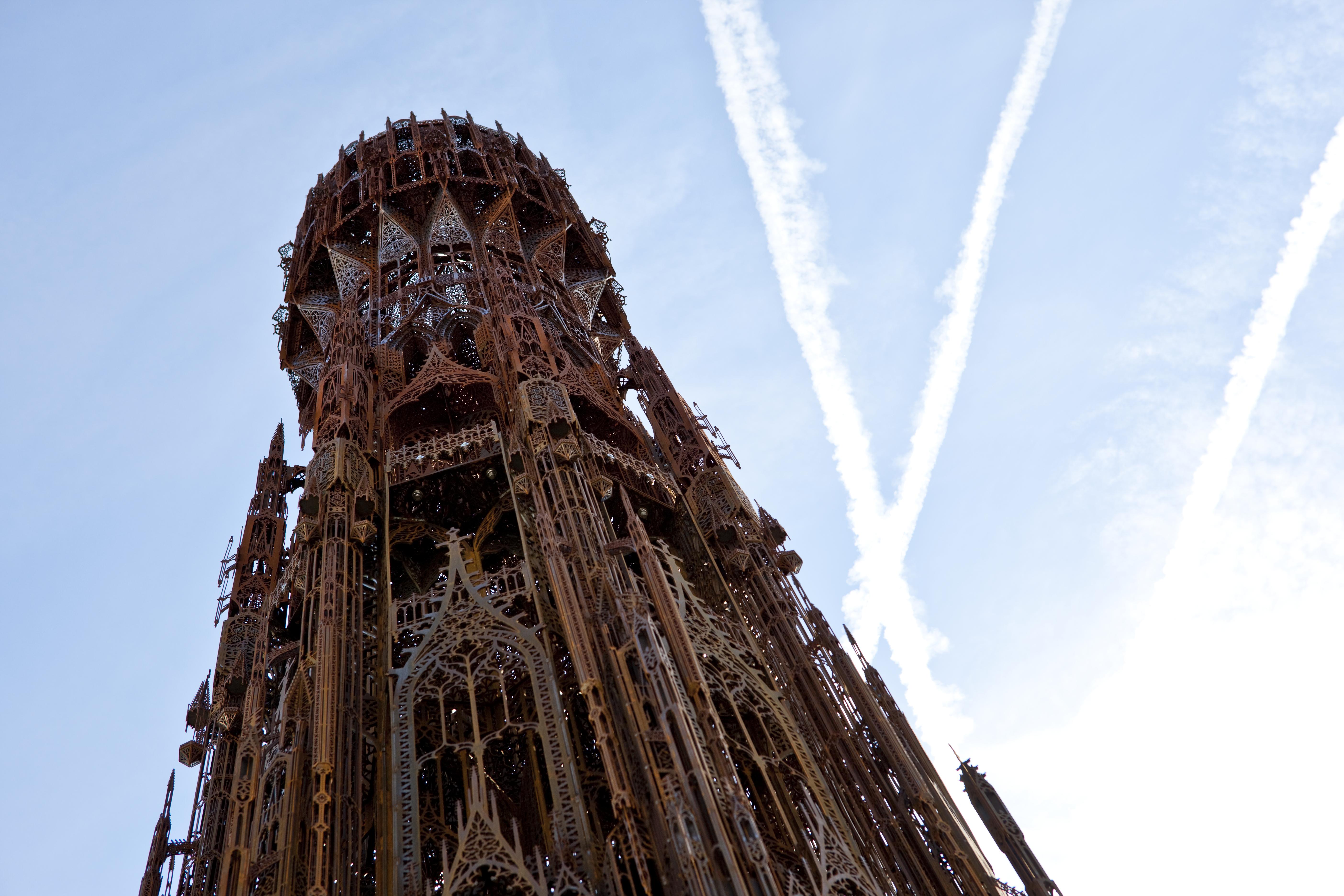
Tour - Brussels: Media: Laser-cut corten steel Dimensions: H 1700 x 260 x 260 cm Date: 2010 View: Knockin' on heaven's door (20.10.2010 - 23.01.2011) at Bozar, Brussels, © Wim Delvoye
Delvoye's Disneyland
Delvoye is dreaming up even larger projects. He would like to be commissioned to build museums. "I want to build castles, towers, staircases. I am not cheap but I am less expensive than maybe others - I mean we are not talking more than one Picasso to do a huge project!"
His work continues to use highly skilled craftsmanship. The Gothic trucks are beautifully ornate, and it doesn't take art history to appreciate the intricacy of the filigreed work.
"Yes that's so eternal. How do you judge archeological stuff? How do you judge sculpture...why does culture for thousands of years focus on craftsmanship and then all of a sudden in the 20th century it stops?! The expectation is if you are literate, you like abstract art, monochromes and conceptual art - the reasoning is that working class people are too stupid to understand modern art."
His current project involves buying a castle to convert into an architectural project, a kind of museum. His recent Cor-Ten towers could be construed as pure architectural elements -and here again he is challenging the compartmentalizing of art in areas traditionally "off-limits." His ironic art, and gothic dumptrucks are popular, but he feels the need to move on. "The market would want me to continue this work. But I see the conservative forces in the market."
"For the 60s generation - Lichtenstein, for instance, was making variations of the same theme his whole life...an artist cannot be like that anymore, because now you need to react to what you see and hear the media all the time... I cannot think of the earth without evolution"
"You need to be constantly flexible. What is art today? You can make an animation and put it on YouTube and it can be more important than a museum show!" One can become an antiquarian very quickly Delvoye believes - it being impossible to predict what might be relevant three months from today. "I was thinking when I was a child if a genie came out of a bottle and offered a crystal ball into my future and said, you are going to have shows in China, and you will sell to people in Yemen or India...I wouldn't have believe it."
One thing is certain, whatever the future, Delvoye will be poking at its frontiers and making news.
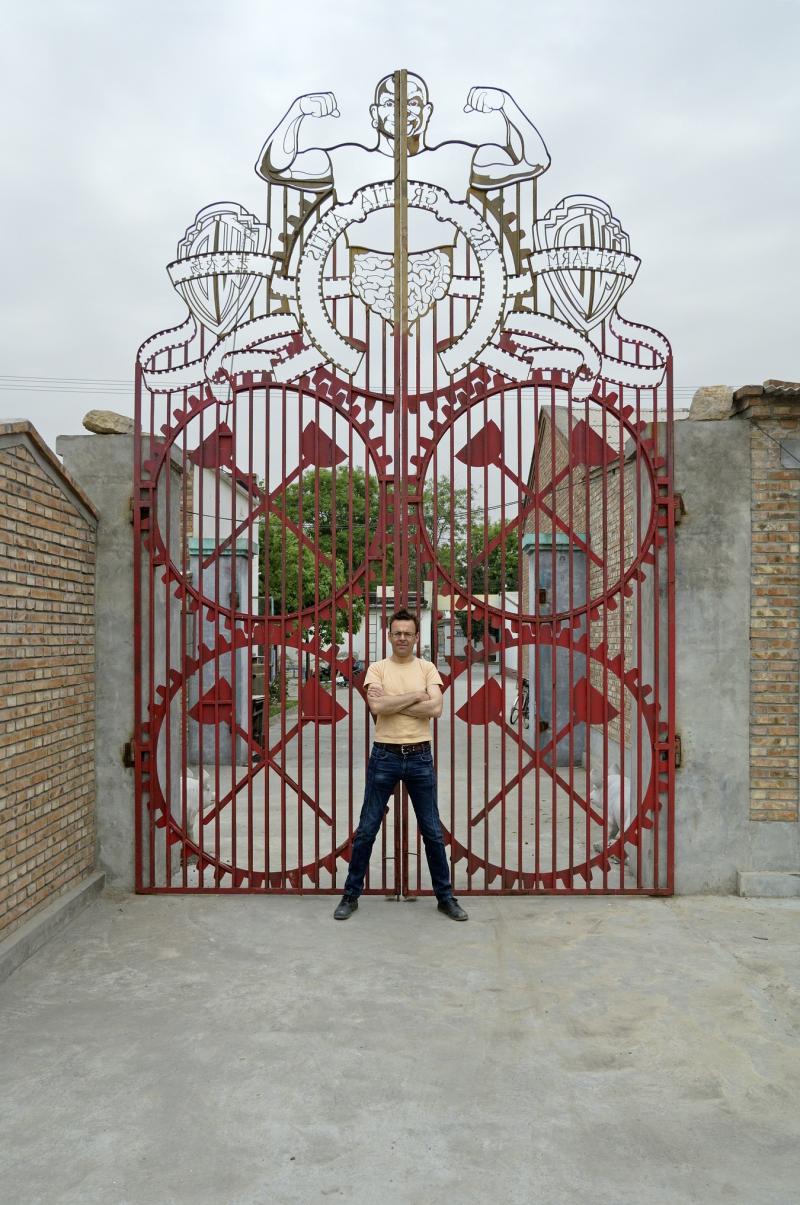
Wim Delvoye in front of Cloaca Gate - © Wim Delvoye
Interviews:Kisa Lala
